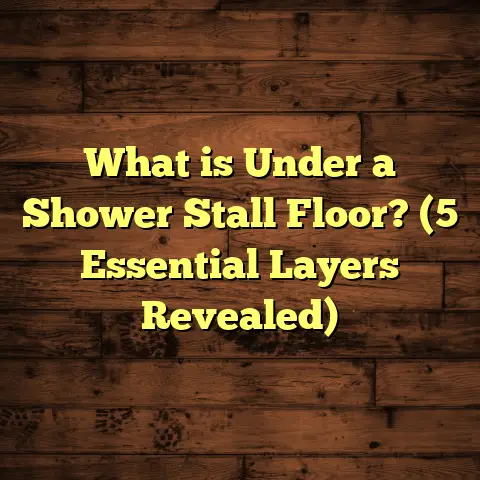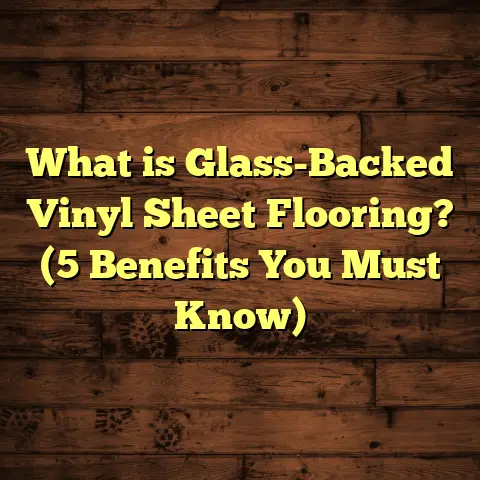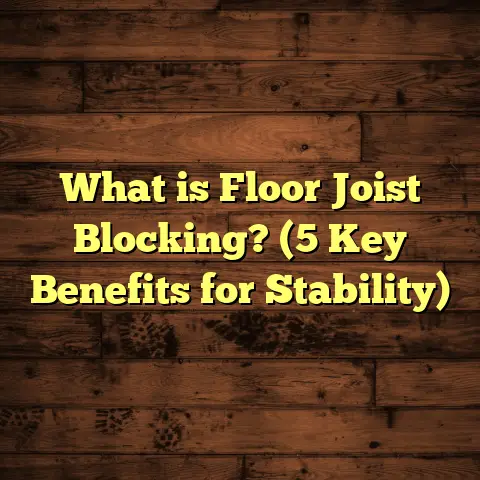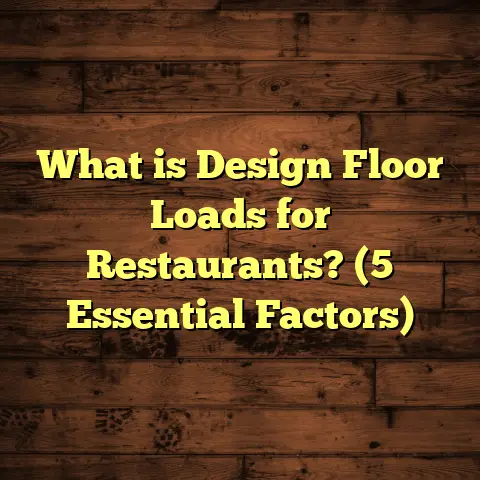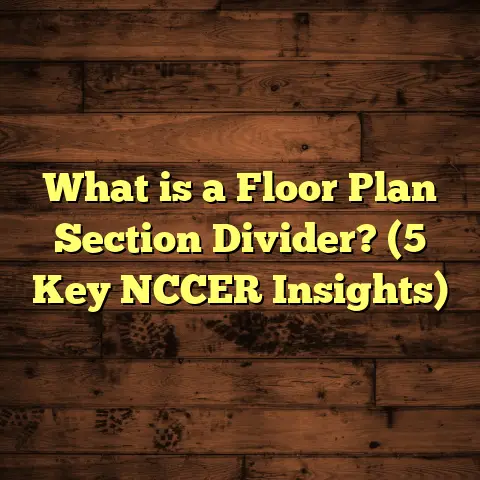What is a Parquet Floor? (5 Types You Need to Know)
What is a Parquet Floor?
Have you ever stepped onto a floor and instantly felt it was more than just wood beneath your feet? That’s the charm of parquet flooring. I’ve been working with floors for years, and nothing quite compares to the artistry and personality parquet brings into a space. So let me tell you about it—this “must-have” flooring option that blends beauty with craftsmanship.
Parquet flooring is a style of wood flooring made from small pieces of hardwood arranged in distinctive, decorative patterns. Unlike traditional hardwood floors where long planks run parallel, parquet is a mosaic of wood blocks or strips that form geometric shapes. It’s like turning your floor into a piece of art you can walk on every day.
This style dates back hundreds of years. In fact, it was first used in 17th-century France to replace marble floors in royal palaces. The idea was to create a warm, elegant look without the coldness or expense of stone.
But what exactly makes parquet floors special? And which types should you know about if you’re considering it for your home? Let me take you through everything I’ve learned from years in the flooring business.
Why Parquet Flooring Caught My Attention
When I first got involved with parquet floors, I was fascinated by how much skill and patience goes into creating them. Most people assume hardwood floors are just long planks nailed down—but parquet is different. It’s about precision and pattern.
I remember one early project where I installed a herringbone pattern for a client’s dining room. The room was modest in size, but the floor made it feel instantly sophisticated and larger due to the pattern’s diagonal lines. Watching each small piece fit perfectly with the next—it felt like solving a giant wood puzzle.
Parquet offers several benefits beyond looks:
- Durability: Because it uses hardwood species like oak or walnut, parquet floors hold up well over time.
- Scratch Camouflage: The varied grain directions hide everyday wear better than uniform planks.
- Design Variety: Patterns range from simple to complex, letting you customize your space.
- Value: Parquet floors can increase your home’s resale value because they’re seen as premium features.
If you want something that stands out from typical hardwood but still delivers warmth and longevity, parquet is worth exploring.
Five Types of Parquet Flooring You Should Know About
After installing and restoring many parquet floors, I’ve noticed five types that come up most often and offer distinct aesthetics and technical challenges:
1. Herringbone Parquet
Herringbone is probably the most recognized parquet pattern. It consists of rectangular blocks arranged in zig-zag rows, where each block is set at a 90-degree angle to its neighbor.
Why I like it: It adds energy to a space without cluttering it. The pattern naturally draws your eye along diagonal lines, which makes rooms feel bigger. I’ve installed herringbone in everything from compact apartments to large living rooms.
Technical details: Blocks are generally twice as long as they are wide (e.g., 2” x 6” or 3” x 12”). Alignment is critical; even slight deviations show up immediately. Installation involves laying down a precise grid before placing blocks.
Cost considerations: Herringbone typically costs more than straight plank hardwood due to labor intensity—expect around $12-$18 per square foot installed.
2. Chevron Parquet
Chevron looks like herringbone but is cut differently. Instead of rectangular blocks meeting at right angles, chevron pieces are cut at an angle—usually 45 degrees—so their ends meet perfectly to form a continuous zig-zag.
What I’ve noticed: Chevron feels more formal and refined than herringbone. It’s often chosen for grand entryways or dining rooms where the homeowner wants an elegant statement piece.
Installation notes: Precision cutting is even more important here because angled cuts must be exact for the pattern to flow seamlessly. Any errors stick out right away.
Price range: Because of the precision required, chevron usually costs $15-$25 per square foot installed.
3. Basketweave Parquet
Basketweave mimics woven fabric by grouping rectangular blocks in pairs or sets that alternate direction—horizontal then vertical—creating a checkerboard effect with texture.
Why it works: This style feels cozy and traditional without being too busy. I often recommend it for spaces where clients want warmth and character but not overly intricate patterns.
Durability: The grouped blocks create stability against wood movement caused by humidity changes. It also wears evenly over time due to block size.
Typical cost: Basketweave installations tend to be mid-range, about $10-$15 per square foot installed.
4. Versailles Parquet
Versailles parquet is the most complex and ornate pattern of all. It combines squares, triangles, diamonds, and rectangles arranged into large repeating geometric units. This style originated in the Palace of Versailles and screams luxury.
My experience: This pattern requires masterful craftsmanship and takes significantly longer to install. One Versailles project I worked on took nearly twice as long as a standard hardwood floor for the same square footage.
Where it fits: Perfect for grand rooms, historic home restorations, or anyone wanting a lavish centerpiece floor.
Cost factor: Due to labor and material waste (cutting intricate shapes generates more scraps), Versailles floors can cost $20-$35 per square foot or more.
5. Brick Parquet
Brick parquet resembles brick walls with rectangular blocks offset in rows. It’s simpler than herringbone or chevron but still adds texture and interest compared to plain planks.
Best use: For homeowners who want subtle patterning without complexity or high costs. It’s also easier to install than other parquet styles.
Installation tip: Even though it’s simpler, proper subfloor prep and adhesive application are critical for durability.
Cost: Brick parquet tends to be on the more affordable end at $8-$12 per square foot installed.
How I Choose the Right Parquet for a Space
Choosing parquet isn’t just about picking which pattern looks cool (though that’s important!). I always take several factors into account before making recommendations:
- Room size: Larger rooms can handle bigger parquet blocks or complex patterns like Versailles without feeling busy.
- Foot traffic: For heavy-use areas like kitchens or hallways, harder woods like oak or maple are best.
- Style: A modern minimalist room pairs well with herringbone or brick patterns; traditional homes shine with Versailles or basketweave.
- Budget: Complex patterns mean more labor and waste—make sure clients understand upfront.
- Maintenance willingness: Some parquet finishes require regular care; others are low maintenance.
For example, one client wanted parquet in their kitchen but was worried about water damage. We chose engineered oak herringbone with a durable matte finish that resists moisture better than solid hardwood.
The Installation Process: What Happens Behind the Scenes
Installing parquet floors takes patience and precision—definitely not a weekend DIY for most people. Here’s how I approach it step-by-step:
Step 1: Subfloor Preparation
The subfloor must be level, clean, dry, and structurally sound. Any moisture issues must be addressed first to prevent warping later on.
Step 2: Layout Planning
Before placing any blocks, I measure the room carefully and map out the pattern centerline(s). For symmetrical patterns like herringbone or chevron, starting in the center ensures balanced edges.
Step 3: Adhesive Application
I usually use a high-quality wood flooring adhesive suitable for the specific wood species and subfloor type (concrete vs plywood).
Step 4: Placing Blocks
Each block is carefully set into place according to the pattern using spacers or guides for consistent gaps. This step requires constant checking for alignment and level.
Step 5: Sanding & Finishing
If using unfinished parquet tiles or blocks (as opposed to pre-finished), I sand the entire floor to smooth unevenness between blocks and prepare for finishing coats.
Step 6: Sealing
Finally, multiple coats of polyurethane or oil-based finishes are applied to protect the wood from wear and moisture while enhancing its natural color.
Cost Breakdown: What You Can Expect to Pay
You might be wondering how much all this craftsmanship costs. Flooring budgets vary widely depending on materials, labor rates in your area, and pattern complexity.
Here’s a rough breakdown based on my experience:
| Pattern Type | Material Cost (per sq ft) | Labor Cost (per sq ft) | Total Cost Range (per sq ft) |
|---|---|---|---|
| Brick | $3 – $6 | $5 – $7 | $8 – $12 |
| Basketweave | $4 – $8 | $6 – $9 | $10 – $15 |
| Herringbone | $5 – $10 | $7 – $11 | $12 – $18 |
| Chevron | $7 – $12 | $8 – $13 | $15 – $25 |
| Versailles | $10 – $18 | $10 – $17 | $20 – $35+ |
Keep in mind these numbers can shift based on wood species (exotic woods cost more), local labor rates, subfloor prep needs, and finish options.
To get realistic project budgets quickly now, I rely heavily on FloorTally—a tool that factors in local prices for materials and labor plus waste percentages specific to parquet installation. It helps me avoid surprises when discussing costs with clients.
Maintenance Tips: How to Keep Your Parquet Floor Beautiful for Years
Good maintenance extends your floor’s life and keeps it looking fresh. Here are some key tips I share:
- Sweep or vacuum regularly to remove grit that scratches wood.
- Mop with a damp (not wet) microfiber mop using pH-neutral wood cleaners.
- Avoid harsh chemicals or ammonia-based cleaners—they damage finishes.
- Use area rugs in high-traffic zones like hallways.
- Place felt pads under furniture legs.
- Control indoor humidity between 40%-60% to prevent wood expansion/contraction.
- Refinish every 7–10 years depending on wear—sanding down surface scratches restores luster.
I also advise clients living in humid climates to install vapor barriers under their floors during installation for added protection.
Personal Stories From My Parquet Journey
One project that stands out was an old Victorian home restoration where we replaced worn-out floors with Versailles parquet made from reclaimed oak. The owners wanted authenticity but also modern durability.
The installation took longer than expected due to irregular subfloors and wood conditioning needs but seeing those intricate patterns come alive was worth every extra hour. After finishing, the home’s character was transformed—the floor became its centerpiece for guests’ admiration.
On another job, a young couple wanted herringbone in their urban condo but had budget constraints. We opted for engineered oak pre-finished herringbone tiles—installation was quicker, cleaner, and costs stayed manageable while still achieving that classic look.
These experiences taught me that parquet can fit many budgets and styles—it’s all about choosing materials and patterns wisely.
Comparing Parquet With Other Flooring Types
You might be wondering how parquet stacks up against other popular floors like standard hardwood planks, laminate, vinyl planks, or tile. Here’s my take based on years of hands-on work:
| Flooring Type | Visual Appeal | Durability | Installation Difficulty | Maintenance | Cost Range per sq ft |
|---|---|---|---|---|---|
| Parquet Hardwood | Artistic & unique | Very high | High | Moderate | $8 – $35+ |
| Traditional Hardwood | Classic & versatile | High | Moderate | Moderate | $6 – $15 |
| Laminate | Can mimic wood well | Moderate | Low | Low | $2 – $6 |
| Vinyl Planks | Good wood look options | High (waterproof) | Low | Very low | $3 – $7 |
| Tile | Wide design range | Very high | Moderate | Low | $5 – $15 |
Parquet wins on uniqueness and design but requires more skill during installation and upkeep than laminate or vinyl options. For people who want their floors to make a statement that lasts decades, it’s an excellent choice.
Seasonal Care Advice for Parquet Floors
Wood floors react to temperature and humidity changes throughout the year. Here’s how I advise clients to protect their parquet through seasons:
- Winter: Homes tend to be drier; use humidifiers indoors to prevent wood shrinkage which causes gaps between blocks.
- Summer: Higher humidity can cause expansion; ensure windows are closed during rainstorms to avoid excess moisture.
- Spring/Fall: Monitor humidity levels closely during transitional seasons; adjust humidifier/dehumidifier accordingly.
- Year-round: Keep heating/cooling vents clear from blocking airflow near floors; good air circulation helps maintain stable conditions.
Final Thoughts — Is Parquet Right For You?
If you want flooring that offers timeless elegance combined with durability and artistic flair, parquet flooring deserves serious thought. Yes, it requires more planning, precise installation, and some maintenance—but the payoff is floors that become conversation pieces and last generations.
Whether you pick classic herringbone or go bold with Versailles, know that your floor tells a story every time someone walks over it.
And if budgeting feels overwhelming? Tools like FloorTally have helped me give clients realistic numbers fast so we can plan projects confidently without surprises.
I’m always happy to share what works best based on my experience—so if you want help choosing patterns or understanding installation details better just ask!

